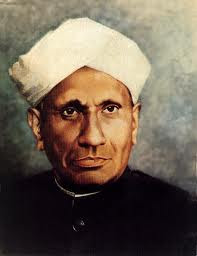Monday, 11 April 2011
Venkata Raman was born at Thiruvanaikaval, near Tiruchirappalli, Madras Presidency to R. Chandrasekhara Iyer (b. 1866) and Parvati Ammal (Saptarshi Parvati).[1] He was the second of their eight children. At an early age, Raman moved to the city of Vizag, Andhra Pradesh. Studied in St.Aloysius Anglo-Indian High School. His father was a lecturer in Mathematics and physics, so he grew up in an academic atmosphere.Raman entered Presidency College, Chennai in 1902. In 1904, he gained his B.Sc., winning the first place and the gold medal in physics. In 1907, he gained his M.Sc., obtaining the highest distinctions. He joined the Indian Finance Department as an Assistant Accountant General.C.V Raman & Bhagavantam, discovered the quantum photon spin in 1932, which further confirmed the quantum nature of light.Raman also worked on the acoustics of musical instruments. He worked out the theory of transverse vibration of bowed strings, on the basis of superposition velocities. He was also the first to investigate the harmonic nature of the sound of the Indian drums such as the tabla and the mridangam.Raman and his student Nagendranath, provided the correct theoretical explanation for the acousto-optic effect (light scattering by sound waves), in a series of articles resulting in the celebrated Raman-Nath theory. Modulators, and switching systems based on this effect have enabled optical communication components based on laser systems.In 1934, Raman became the director of the Indian Institute of Science in Bangalore, where two years later he continued as a professor of physics. Other investigations carried out by Raman were experimental and theoretical studies on the diffraction of light by acoustic waves of ultrasonic and hypersonic frequencies (published 1934-1942), and those on the effects produced by X-rays on infrared vibrations in crystals exposed to ordinary light.He also started a company called Travancore Chemical and Manufacturing Co. Ltd. in 1943 along with Dr. Krishnamurthy. The Company during its 60 year history, established four factories in Southern India. In 1947, he was appointed as the first National Professor by the new government of Independent India.In 1948, Raman, through studying the spectroscopic behavior of crystals, approached in a new manner fundamental problems of crystal dynamics. He dealt with the structure and properties of diamond, the structure and optical behavior of numerous iridescent substances (labradorite, pearly feldspar, agate, opal, and pearls). Among his other interests were the optics of colloids, electrical and magnetic anisotropy, and the physiology of human vision.
Visvesvaraya was born to Srinivasa Shastry and Venkata lakshmamma at Muddenahalli village, Kanivenarayanapura hobli, Chikkaballapur District of present-day Karnataka, in what was then the princely state of Mysore. : Bharatha Rathna Sir M Visvesvaraya (Kan) Purogami Sahitya 1972[verification needed] Srinivasa Sastry was a Sanskrit scholar and an authority on the Hindu scriptures, besides being an Ayurvedic practitioner. His mother was venkata lakshmamma.The family was a pious Telugu-speaking smartha brahmin family of mulkunadu subsect. Visvesvaraya lost his father at the age of 15.[1] He attended primary school at Chikkaballapur and high school at Bangalore.He studied his B.A. at Central College, Bangalore, affiliated to Madras University in 1881 and later studied Civil Engineering at the College of Science, Pune, now known as the College of Engineering, Pune (COEP).[2] sep 15 1860 born died apr 14 1962(101).After opting for voluntary retirement in 1908, he took a foreign tour to study industrialised nations and after, for a short period he worked for Nizam of Hyderabad. He suggested flood relief measures for Hyderabad town, which was under constant threat of floods by Moosi river. Later, during November 1909, Visvesvaraya was appointed as Chief Engineer of Mysore State. Further, during the year, 1912, he was appointed as Diwan (First Minister) of the princely state of Mysore. He was Diwan for 7 years.With the support of Krishnaraja Wodeyar IV, Maharaja of Mysore, Visvesvaraya made an arguably unprecedented contribution as Diwan to the all-round development of the state. Not only the achievements listed above, but many other industries and public works owe their inception or active nurturing to him. He was instrumental in the founding of the Government Engineering College at Bangalore in 1917, one of the first engineering institutes in India. This institution was later named the University Visvesvaraya College of Engineering after its founder. It remains one of the most reputed institutes of engineering in Karnataka. He also commissioned several new railway lines in Mysore states. Visvesvaraya was Sir Mirza Ismail's mentor and in 1926 by way of recommendation to the King who supplemented Mirza Ismail by elevating him to the coveted position of the Diwan of Mysore.In 1915, while he was the Diwan of Mysore, Visvesvaraya was made Knight Commander of the Order of the Indian Empire by the British for his myriad contributions to the public good. After India attained independence, Sir M. Visvesvaraya was given the nation's highest honour, the Bharat Ratna, in 1955.Sir M.V. was honoured with honorary membership of the international Institution of Civil Engineers (based in London) and a fellowship of the Indian Institute of Science (based in Bangalore). He was awarded several honorary doctoral degrees like D.Sc., LL.D., D.Litt. from eight universities in India. He was president of the 1923 Session of the Indian Science Congress. Sir M.V. was awarded honorary Membership of London Institution of Civil Engineers for an unbroken 50 years.
Subscribe to:
Post Comments (Atom)


No comments:
Post a Comment